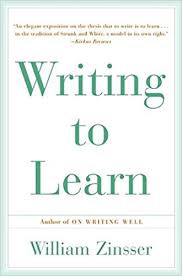Writing to Learn

Writing to Learn by William Zinsser is the third (and last, for now) book on writing I picked up this summer — the others were On Writing Well by Zinsser again, and On Writing by Stephen King. I still like the Stephen King book a whole lot better than the other two — in fact, I liked Writing to Learn, the one I’m reviewing here, the least. Nevertheless, I came out with a strong validation of an idea I’ve always had in my head: that writing about something is one of the best ways to learn it.
Writing is thinking on paper. Anyone who thinks clearly should be able to write clearly — about any subject at all.
The main idea that Zinsser focusses on in this book is called “Writing Across The Curriculum.” It’s the trend in American colleges for including writing as an integral part of all disciplines: a move designed to teach students not only to write well but to think clearly too. The book takes us on a journey to explore the importance of writing across subjects beyond the usual humanities: from chemistry to mathematics all the way to physics.
In Zinsser’s own words, “Writing is learned mainly by imitation. Therefore I decided to look for the literature myself: to collect brief examples of good, accessible writing in a variety of academic disciplines.” A considerable portion of the book is straight-up examples of great writings in fields where you’d expect it the least: music, geography, art, sociology, and of course, economics.
Although the book seemed more like a collection of good works of writing rather than a lot of original writing itself, I came out with some valuable quotes from Zinsser on the craft. I’ll leave you with a few of those here:
“Clear writing is the logical arrangement of thought; a scientist who thinks clearly can write as well as the best writer.”
This was the central theme of the book, repeated over and over again.
“The essence of writing is rewriting. Very few writers say on their first try exactly what they want to say.”
This harkens back to what Stephen King repeated over and over in On Writing. Remember, “Second Draft = First Draft minus 10%.”
“Learn to use the tools without fear. They are not some kind of secret apparatus owned by the English teacher or any other teacher. They are simple mechanisms for putting your thoughts on paper. Take as much pleasure in what an active verb will do for you as in what a mathematical formula will do, or a computer, or a centrifuge. The self-esteem will then take care of itself.”
This is so true. We don’t think of words that make up parts of sentences as tools. But that’s exactly what they are — if every great writer says that you should use more active verbs, then just do so. Think of each word as a tool, and how you can hire it to write better.
This is #35 in a series of book reviews published weekly on this site.
